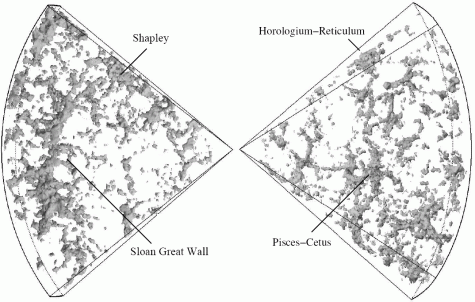Examining the Great Wall

Structure exists on nearly all scales in the universe. Matter clumps under its own gravity into planets, stars, galaxies, clusters, and superclusters. Beyond even these in scale are the filaments and voids. The largest of these filaments is known as the Sloan Great Wall. This giant string of galaxies is 1.4 billion light years across making it the largest known structure in the universe. Yet surprisingly, the Great Wall has never been studied in detail. Superclusters within it have been examined, but the wall as a whole has only come into consideration in a new paper from a team led by astronomers at Tartu Observatory in Estonia.
The Sloan Great Wall was first discovered in 2003 from the Sloan Digital Sky Survey (SDSS). The survey mapped the position of hundreds of millions of galaxies revealing the large scale structure of the universe and uncovering the Great Wall.
Within it, the wall contains several interesting superclusters. The largest of these SCl 126 has been shown previously to be unusual compared to superclusters within other large scale structures. SCl 126 is described as having an exceptionally rich core of galaxies with tendrils of galaxies trailing away from it like an enormous “spider”. Typical superclusters have many smaller clusters connected by these threads. This pattern is exemplified by one of the other rich superclusters in the wall, SCl 111. If the wall is examined in only its densest portions, the tendrils extending away from these cores are quite simple, but as the team explored lower densities, sub filaments became apparent.
Another way the team examined the Great Wall was by looking at the arrangement of different types of galaxies. In particular, the team looked for Bright Red Galaxies (BRGs) and found that these galaxies are often found together in groups with at least five BRGs present. These galaxies were often the brightest of the galaxies within their own groups. As a whole, the groups with BRGs tended to have more galaxies which were more luminous, and have a greater variety of velocities. The team suggests that this increased velocity dispersion is a result of a higher rate of interactions among galaxies than in other clusters. This is especially true for SCl 126 where many galaxies are actively merging. Within SCl 126, these BRG groups were evenly distributed between the core and the outskirts while in SCl 111, these groups tended to congregate towards the high density regions. In both of these superclusters, spiral galaxies comprised about 1/3 of the BRGs.
The study of such properties will help astronomers to test cosmological models that predict galactic structure formation. The authors note that models have generally good job of being able to account for structures similar to SCl 111 and most other superclusters we have observed in the universe. However, they fall short in creating superclusters with the size, morphology and distribution of SCl 126. These formations arise from density fluctuations initially present during the Big Bang. As such, understanding the structures they formed will help astronomers to understand these perturbations in greater detail and, in turn, what physics would be necessary to achieve them. To help achieve this, the authors intend to continue mapping the morphology of the Sloan Great Wall as well as other superclusters to compare their features.
Source: Universe Today



















